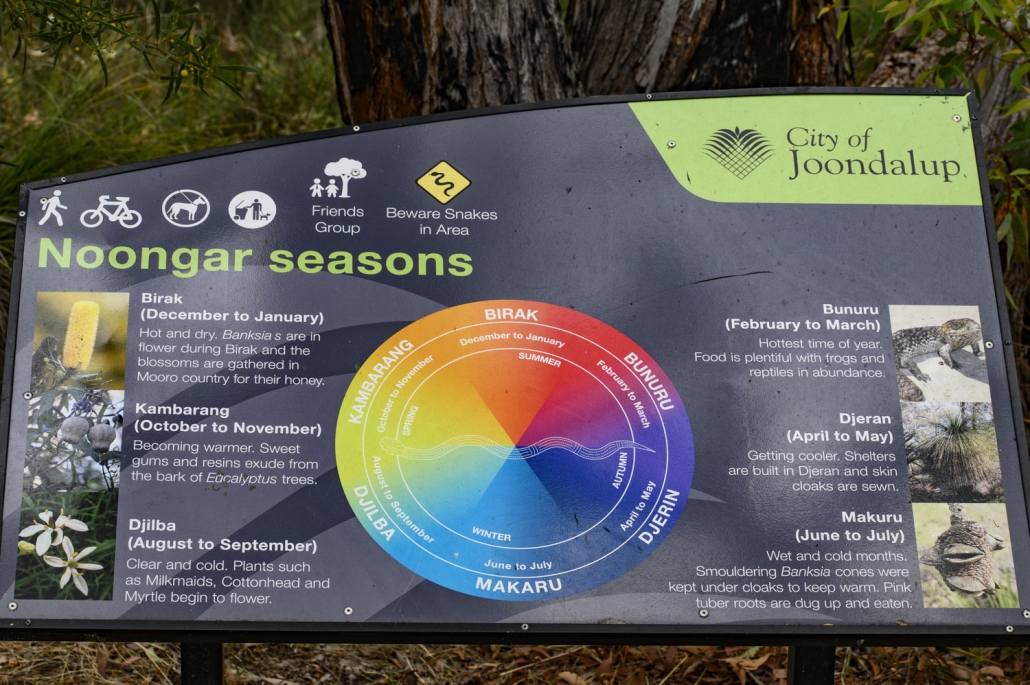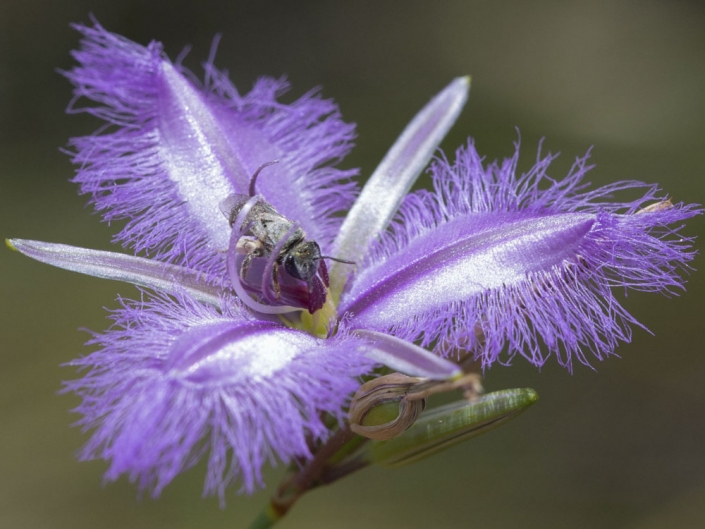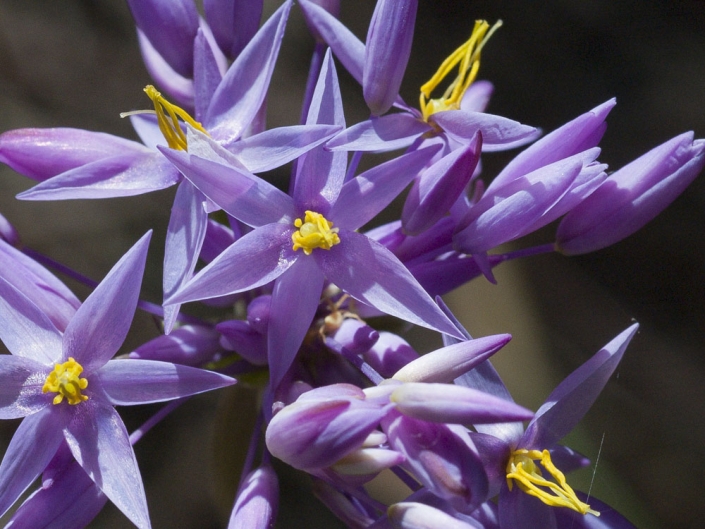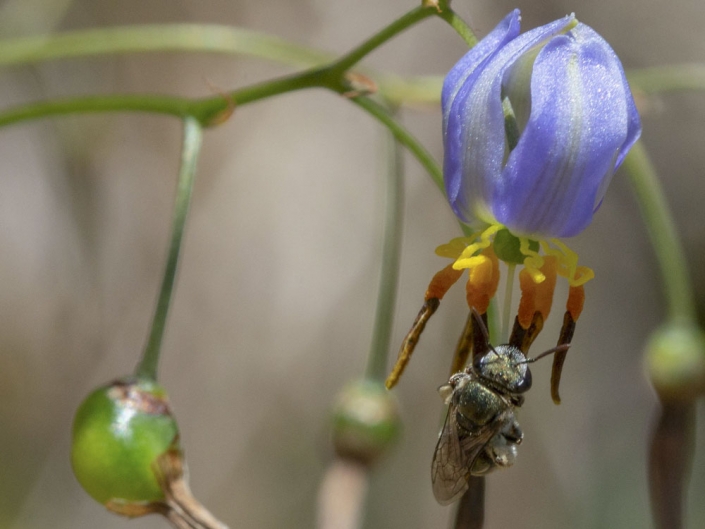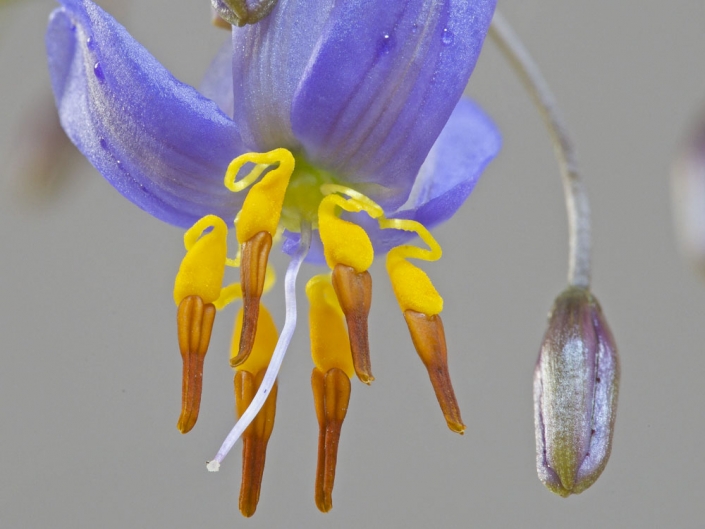3. Bench and Six Seasons Sign
At this point there is a large, dead, fire-scarred jarrah trunk and the eastern entrance to the side-trail loop. A newer bench is also located here. Wildflowers include Native Wisteria, irises, and orchids. Please keep off trackside areas which are being restored to encourage orchids and other wildflowers to grow near the path. A bat box is located in a large jarrah tree nearby.
Common Wildflowers
Winter – Native Wisteria (Hardenbergia comptoniana)
Spring – Purple Tassels (Sowerbaea laxiflora), Native Cycad (Macrozamia fraseri), Pansy Orchid (Diuris magnifica)
Late Spring & Early Summer – Purple Flag (Patersonia occidentalis), Flax lily (Dianella revoluta var. revoluta), Pineapple Bush (Dasypogon bromeliifolius), Balga, Blue Devil (Eryngium pinnatifidum), Pagoda Triggerplant (Stylidium neurophyllum), Hairy Yellow Pea (Gompholobium tomentosum), Jarrah, Candle Banksia
Focus Topic 5. Six Aboriginal Seasons
A sign is located here which explains the Noongar seasonal calendar for Southwest Western Australia. This calendar has six seasons in a yearly cycle. These are Birak, Bunuru, Djeran, Makuru, Djilba and Kambarang. They can be roughly equated to the European calendar as shown on the sign. Seasons can be long or short and are indicated by what is happening and changing rather than by dates on a calendar. For example, the flowering of many different plants, the hibernation of reptiles and the moulting of swans are all indicators that the seasons are changing.
This six-season calendar is extremely important to Noongar people, as it is a guide to what nature is doing at every stage of the year, as well as understanding respect for the land in relation to plant and animal fertility cycles and land and animal preservation. Information on aboriginal names and plant uses is primarily from “City of Joondalup, 2019, Plants and People in Mooro Country: Noongar Plant Use in Yellagonga Regional Park (Third Edition 2019), Perth, WA.”
Focus Topic 6. Flax Lily Pollination is a Buzz
The Flax Lily (Dianella revoluta var. divaricata) is a perennial herb (non-woody plant) found widely across Australia. It is a tough, drought tolerant species with long fibrous leaves and small delicate purple or blue flowers on a tall branching stem in early summer or late spring. Dianella revoluta was first described in 1810 by Robert Brown and its scientific name is based on the way the margins of the leaves roll back on themselves. The flax lily is well named, as for thousands of years its leaves have been harvested and processed to create string and woven articles. Aboriginal people found many uses for its fibrous leaves. They also ate the small blue berries that form after the flowers are pollinated.
Blue-banded bees are native insects that prefer warm weather. They love the flowers of flax lily and vibrate their wings at a specific frequency to release the pollen onto their hairy bodies. This is known as “buzz pollination”. Only native bees can create the frequency needed to release the pollen, forming very specific plant-pollinator relationships. Other local buzz-pollinated plants include Pearl Flower (Conostephium pendulum), Hibbertia species, Purple Tassels and fringe lilies, as shown below. These all have anthers that are closed except for an apical pore or narrow slit and lack nectar. Thus, most pollinating insects will not find food in them.






